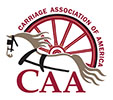Vicki Nelson Bodoh, Joe Jennings, Roger Murray, Jerry D. Rider, and Geoffrey Ryder are contributors to this reprint of the 1983 classic, Carriage Restoration: Here’s How. This new version has been completely updated and revised; it contains many black-and-white images and color photographs. Chapters include preparatory work, painting and striping, trimming, and imitation canework with many subchapters. The book is available through the CAA Bookstore.

Sample from the book –
Finishing Materials
The finest carriages trimmed in wool broadcloth or silk usually had seat falls, door pockets, etc., finished with carriage lace. This lace was woven in a great range of qualities, some from cotton with figuring of wool worsted, some with silk figuring (see Figure 15).The designs were more or less elaborate and the color chosen would match the trimming fabric.The various kinds of carriage lace are broad lace, made in 2.5-inch to 3.5-inch widths or more and used for seat falls, etc; seaming lace (sometimes called piping,) with a cord sewn in to make cushion edges; and pasting lace, made in .5-inch or .75-inch widths and used to cover tacks or nail heads, or where other parts of trimming are joined.
Carriage lace is still made in a limited range of patterns and colors and, occasionally, some older stock can be found. When complete authenticity is necessary, it is still possible to have carriage lace hand woven, but this is costly. Made-up edge welts and bindings for leather trimming can also be obtained.
